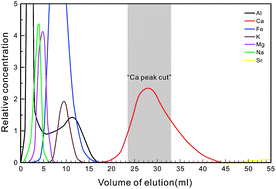当前位置:
X-MOL 学术
›
J. Anal. At. Spectrom.
›
论文详情
Our official English website, www.x-mol.net, welcomes your
feedback! (Note: you will need to create a separate account there.)
A “peak cut” procedure of column separation for calcium isotope measurement using the double spike technique and thermal ionization mass spectrometry (TIMS)
Journal of Analytical Atomic Spectrometry ( IF 3.1 ) Pub Date : 2018-02-14 00:00:00 , DOI: 10.1039/c8ja00004b Hongli Zhu 1, 2, 3, 4, 5 , Fang Liu 1, 2, 3, 4, 5 , Xin Li 1, 2, 3, 4, 5 , Yajun An 1, 2, 3, 4, 5 , Guiqin Wang 1, 2, 3, 4, 5 , Zhaofeng Zhang 1, 2, 3, 4, 5
Journal of Analytical Atomic Spectrometry ( IF 3.1 ) Pub Date : 2018-02-14 00:00:00 , DOI: 10.1039/c8ja00004b Hongli Zhu 1, 2, 3, 4, 5 , Fang Liu 1, 2, 3, 4, 5 , Xin Li 1, 2, 3, 4, 5 , Yajun An 1, 2, 3, 4, 5 , Guiqin Wang 1, 2, 3, 4, 5 , Zhaofeng Zhang 1, 2, 3, 4, 5
Affiliation

|
Full recovery from column separation and matrix effects are the two factors that need to be considered for the high-precision analysis of stable Ca isotopes, but generally they are difficult to balance. In many cases, to get a pure Ca fraction, the interference of the matrix elements is reduced at the cost of discarding a fraction of Ca overlapping with other elements (e.g. Sr and K). However, quantitative evaluation using this approach is challenging but greatly needed. Our study investigates the influence of low Ca recovery on δ44/40Ca using thermal ionization mass spectrometry (TIMS) with the double spike technique. δ44/40Ca of IAPSO seawater, ML3B-G and BHVO-2 in different Ca subcuts (e.g. 0–20, 20–40, 40–60, 60–80 and 80–100%), display limited variation after iterative correction by 42Ca–43Ca double spike with the exponential law. Notably, δ44/40Ca of each Ca subcut with ∼20% recovery is consistent with that of the Ca cut with full recovery, within a margin of error. Our results indicate that 42Ca–43Ca double spike technique can simultaneously correct Ca isotopic fractionation, occurring during column separation, and TIMS determination, because both follow the exponential fractionation law well. Therefore, a “peak cut” procedure of column separation for Ca isotope measurement using the double spike technique on TIMS is proposed. Briefly, we can mix the double spike with the sample solution well before column separation, then collect the peak of the Ca cut and abandon both sides of the Ca eluate that may overlap with other elements. This procedure would eliminate matrix effects efficiently, especially for samples with low CaO contents which typically must be passed through the column twice (e.g. peridotite and dunite).
中文翻译:

使用双峰技术和热电离质谱(TIMS)的钙同位素测量色谱柱分离的“峰切割”程序
从色谱柱分离中完全回收和基质效应是对稳定的Ca同位素进行高精度分析时需要考虑的两个因素,但通常很难平衡。在许多情况下,要获得纯Ca分数,可以减少基质元素的干扰,但要舍弃与其他元素(例如Sr和K)重叠的Ca分数。但是,使用这种方法进行定量评估具有挑战性,但非常需要。我们的研究使用双尖峰技术通过热电离质谱(TIMS)研究了低Ca回收率对δ44/40 Ca的影响。δ 40分之44采购处海水的钙,ML3B-G和BHVO-2在不同的Ca subcuts(例如0–20、20–40、40–60、60–80和80–100%),在用指数律通过42 Ca– 43 Ca双尖峰进行迭代校正后,显示出有限的变化。值得注意的是,每个Ca子馏分的δ44/40 Ca的回收率约为20%,与完全回收的Ca馏分的δ44/40 Ca一致,误差范围内。我们的结果表明42 Ca– 43Ca双加标技术可以同时校正在色谱柱分离和TIMS测定过程中发生的Ca同位素分馏,因为两者都很好地遵循了指数分级法。因此,提出了在TIMS上使用双尖峰技术进行钙同位素测量的色谱柱分离的“峰切割”程序。简而言之,我们可以在色谱柱分离前将双峰与样品溶液充分混合,然后收集Ca截峰并放弃可能与其他元素重叠的Ca洗脱液的两面。该程序将有效地消除基体效应,特别是对于CaO含量较低的样品,通常必须两次通过色谱柱(例如橄榄岩和辉光岩)。
更新日期:2018-02-14
中文翻译:

使用双峰技术和热电离质谱(TIMS)的钙同位素测量色谱柱分离的“峰切割”程序
从色谱柱分离中完全回收和基质效应是对稳定的Ca同位素进行高精度分析时需要考虑的两个因素,但通常很难平衡。在许多情况下,要获得纯Ca分数,可以减少基质元素的干扰,但要舍弃与其他元素(例如Sr和K)重叠的Ca分数。但是,使用这种方法进行定量评估具有挑战性,但非常需要。我们的研究使用双尖峰技术通过热电离质谱(TIMS)研究了低Ca回收率对δ44/40 Ca的影响。δ 40分之44采购处海水的钙,ML3B-G和BHVO-2在不同的Ca subcuts(例如0–20、20–40、40–60、60–80和80–100%),在用指数律通过42 Ca– 43 Ca双尖峰进行迭代校正后,显示出有限的变化。值得注意的是,每个Ca子馏分的δ44/40 Ca的回收率约为20%,与完全回收的Ca馏分的δ44/40 Ca一致,误差范围内。我们的结果表明42 Ca– 43Ca双加标技术可以同时校正在色谱柱分离和TIMS测定过程中发生的Ca同位素分馏,因为两者都很好地遵循了指数分级法。因此,提出了在TIMS上使用双尖峰技术进行钙同位素测量的色谱柱分离的“峰切割”程序。简而言之,我们可以在色谱柱分离前将双峰与样品溶液充分混合,然后收集Ca截峰并放弃可能与其他元素重叠的Ca洗脱液的两面。该程序将有效地消除基体效应,特别是对于CaO含量较低的样品,通常必须两次通过色谱柱(例如橄榄岩和辉光岩)。











































 京公网安备 11010802027423号
京公网安备 11010802027423号